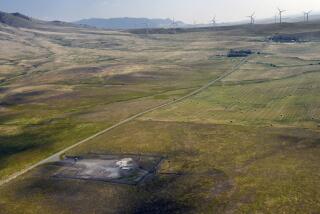Ojai Residents Fight Tower on 2 Fronts : Courts: They say system emits dangerous low-level radiation waves and that federal workers had no right to cross neighbor’s property to reach the facility.
Fearful that radiation from a microwave tower looming above their back yards could eventually kill them, a group of upper Ojai residents is fighting the government on two fronts.
They have hired lawyers to argue today in Ventura County Superior Court that landowners William and Ernestine Kee--who leased land for the tower--had no right to allow federal workers across a neighbor’s property to reach the tower.
Next week attorneys for the residents plan to ask a federal judge to force the government to conduct an in-depth environmental assessment of the weather-tracking tower before work is completed on the system.
The microwave system emits low-level radiation waves deemed safe by the National Weather Service, which said the system would create no significant impacts on the community.
But other scientists, including a team of researchers from the federal Environmental Protection Agency, have said the radar waves might not be completely safe.
Both teams of attorneys representing the Ojai Valley residents are confident they will win in court.
“The law’s the law and the facts are the facts,” said attorney Richard C. Loy, who lives near the site and will argue the Superior Court case. “I think we’re in pretty good shape.”
The tower, which resembles a giant steel ball perched atop a wiry black scaffold, was erected virtually overnight on a steep Sulphur Mountain ridge early last month. It is one of 115 such systems the weather service is building across the country under a $4.5-billion renovation.
The weather station will replace an aging antenna mounted atop the federal building in West Los Angeles, providing military leaders with more accurate weather data, according to Thomas Potter, the weather service’s top regional official.
“It is urgent that the Sulphur Mountain radar become operational as soon as possible,” Potter said in court papers.
But more than 100 residents calling themselves the Environmental Coalition of Ojai say they fear that extended exposure to the radiation may cause cancer or other diseases in their families over coming years.
The coalition is a well-heeled group of property owners made up of many of the same people who last year derailed the proposed Weldon Canyon landfill.
They mobilized quickly after the tower was erected last month, hiring two teams of lawyers to fight the project.
“We’re attacking the problem from all angles,” Loy said.
Superior Court Judge John J. Hunter already granted a temporary order against the Kees that prohibits them from allowing commercial vehicle traffic across an easement they use to enter and leave their ranch.
Lawyers for the group today will ask for an injunction to continue the ban on government access to the site.
“There’s no dispute about the law,” Loy said. “A prescriptive easement is limited to the use by which it was gained. (The Kees) used it for residential purposes, therefore anyone picking up that easement can only use it for residential purposes.”
Dozens of government workers had been crossing plaintiff Agnes Baron’s land to reach the tower to finish installing the radar system.
But Hunter agreed with Loy and said that since the access road had never before been used for commercial trucks, the Kees were not entitled to include use of the easement in their lease agreement with the federal government.
Todd Morris of the National Weather Service office in Oxnard said Wednesday that construction work on the tower stopped when the restraining order was issued.
Attorney William B. Parker of Ventura, who represents the Kees, declined comment Wednesday on the case.
But he said in court papers that Baron and her team of lawyers are using the easement issue only to try and stop the government from switching on the system.
The Kees’ attorney also has requested that Hunter remove himself from the case, contending the judge is prejudiced against the defendants. That issue also is scheduled to be decided today.
Last week, the U.S. attorney’s office in Los Angeles tried to get the easement case transferred from Ventura County Superior Court to U.S. District Court.
But U.S. District Judge Henry Hupp ruled that since the government was not a direct party in the Baron vs. Kees case, he could not make such an order.
Coalition co-Chairman David Hedman said there is ample reason to require the government to perform a detailed environmental assessment before it finishes constructing the Sulphur Mountain radar station.
“New studies say this can be a very harmful radiation that breaks down DNA,” said Hedman, who lives just beneath the 98-foot tower. “We feel the government has broken its own environmental laws.”
More to Read
Sign up for Essential California
The most important California stories and recommendations in your inbox every morning.
You may occasionally receive promotional content from the Los Angeles Times.










